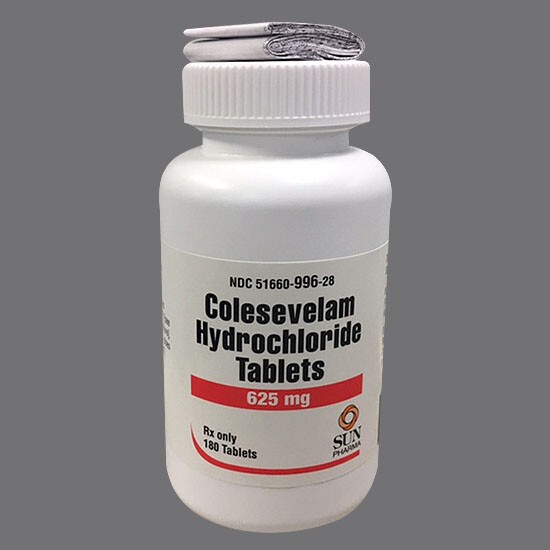
colesevelam – oral, Welchol
Medication Uses How To Use Side Effects Precautions Drug Interactions Overdose Notes Missed Dose Storage USES: This medication is used along with a proper diet and exercise to lower cholesterol in people with high levels of cholesterol in the blood. Lowering cholesterol decreases the risk of heart disease and helps prevent strokes and heart attacks.Colesevelam is also used along with a proper diet and exercise to lower high blood sugar in people with type 2 diabetes. Controlling high blood sugar helps prevent kidney damage, blindness, nerve problems, loss of limbs, and sexual function problems. Proper control of diabetes may also lessen your risk of a heart attack or stroke.Colesevelam belongs to a class of drugs called bile acid-binding resins. Bile acid is a natural substance the liver makes by using cholesterol. This medication works by removing bile acid from the body. This causes the liver to make more bile acid by using cholesterol, which reduces cholesterol levels in the blood. It is not known how colesevelam works in lowering blood sugar. HOW TO USE: Take this medication by mouth with a meal, usually 1 to 2 times daily or as directed by your doctor. Take the tablet form with a liquid (such as water, milk). If you have difficulty swallowing the tablet, talk to your doctor about switching to the powder form of this medication.If you are using the powder form of this medication, pour the contents of one packet into a glass. Add one-half to one cup (4 to 8 ounces or 120 to 240 milliliters) of water, fruit juice, or diet soda. Stir the mixture well and drink. Do not take the powder without mixing it in liquid.Take this medication regularly to get the most benefit from it. To help you remember, take it at the same time(s) each day.It may take several weeks before you get the full benefit of this drug.Colesevelam may decrease the absorption of other products you may be taking. Some examples include cyclosporine, glipizide, glimepiride, glyburide, levothyroxine, and phenytoin, as well as birth control pills that contain ethinyl estradiol and norethindrone. Take other medications as directed by your doctor, usually at least 4 hours before taking your colesevelam dose. Ask your pharmacist if you are not sure when to take your medications. SIDE EFFECTS: Constipation and upset stomach may occur. If any of these effects persist or worsen, tell your doctor or pharmacist promptly.To help prevent constipation, maintain a diet adequate in fiber, drink plenty of water, and exercise. If you become constipated while using this drug, consult your pharmacist in selecting a stool softener or a laxative.Remember that your doctor has prescribed this medication because he or she has judged that the benefit to you is greater than the risk of side effects. Many people using this medication do not have serious side effects.Tell your doctor immediately if any of these unlikely but serious side effects occur: nausea/vomiting, stomach/abdominal pain, trouble swallowing, unusual bleeding/bruising.This medication does not usually cause low blood sugar (hypoglycemia). Low blood sugar may occur if this drug is prescribed with other anti-diabetic medications, or if you do not consume enough calories from food, or if you do unusually heavy exercise.Symptoms of low blood sugar include sudden sweating, shaking, fast heartbeat, hunger, blurred vision, dizziness, or tingling hands/feet. It is a good habit to carry glucose tablets or gel to treat low blood sugar. If you don’t have these reliable forms of glucose, rapidly raise your blood sugar by eating a quick source of sugar such as table sugar, honey, or candy, or drink fruit juice or non-diet soda. Tell your doctor immediately about the reaction and the use of this product. To help prevent low blood sugar, eat meals on a regular schedule, and do not skip meals. Check with your doctor or pharmacist to find out what you should do if you miss a meal.Symptoms of high blood sugar (hyperglycemia) include thirst, increased urination, confusion, drowsiness, flushing, rapid breathing, and fruity breath odor. If these symptoms occur, tell your doctor immediately. Your dosage may need to be increased.A very serious allergic reaction to this drug is rare. However, seek immediate medical attention if you notice any symptoms of a serious allergic reaction, including: rash, itching/swelling (especially of the face/tongue/throat), severe dizziness, trouble breathing.This is not a complete list of possible side effects. If you notice other effects not listed above, contact your doctor or pharmacist.In the US -Call your doctor for medical advice about side effects. You may report side effects to FDA at 1-800-FDA-1088.In Canada – Call your doctor for medical advice about side effects. You may report side effects to Health Canada at 1-866-234-2345.
PRECAUTIONS: Before taking colesevelam, tell your doctor or pharmacist if you are allergic to it; or if you have any other allergies. This product may contain inactive ingredients, which can cause allergic reactions or other problems. Talk to your pharmacist for more details.Before using this medication, tell your doctor or pharmacist your medical history, especially of: pancreatitis (caused by high triglyceride levels), high triglyceride levels, trouble swallowing, stomach/intestinal disorders (such as constipation, blockage, gastroparesis), recent major intestinal surgery, hemorrhoids.Because this drug can interfere with the absorption of certain vitamins (such as vitamins A, D, E, K) when used for a long period of time, your doctor may direct you to take a multivitamin supplement. Take the multivitamin at least 4 hours before taking your colesevelam dose.The powder form of this medication may contain aspartame. If you have phenylketonuria (PKU) or any other condition that requires you to restrict your intake of aspartame (or phenylalanine), consult your doctor or pharmacist about using this medication safely.Tell your doctor if you are pregnant before using this medication.This medication is unlikely to pass into breast milk or harm a nursing infant. Consult your doctor before breast-feeding. DRUG INTERACTIONS: See also How to Use section.Drug interactions may change how your medications work or increase your risk for serious side effects. This document does not contain all possible drug interactions. Keep a list of all the products you use (including prescription/nonprescription drugs and herbal products) and share it with your doctor and pharmacist. Do not start, stop, or change the dosage of any medicines without your doctor’s approval.A product that may interact with this drug includes: warfarin.Beta-blocker medications (such as metoprolol, propranolol, glaucoma eye drops such as timolol) may prevent the fast/pounding heartbeat you would usually feel when your blood sugar level falls too low (hypoglycemia). Other symptoms of low blood sugar, such as dizziness, hunger, or sweating, are unaffected by these drugs.Many drugs can affect your blood sugar levels, making it more difficult to control your blood sugar. Before you start, stop, or change any medication, talk with your doctor or pharmacist about how the medication may affect your blood sugar. Check your blood sugar levels regularly as directed by your doctor. Tell your doctor about the results and of any symptoms of high or low blood sugar. (See also Side Effects section.) Your doctor may need to adjust your anti-diabetic medication, exercise program, or diet. OVERDOSE: If overdose is suspected, contact a poison control center or emergency room immediately. US residents can call their local poison control center at 1-800-222-1222. Canada residents can call a provincial poison control center.
QUESTION
NOTES: Do not share this medication with others.Laboratory and/or medical tests (such as blood cholesterol levels, blood sugar levels) should be performed periodically to monitor your progress or check for side effects. Consult your doctor for more details.Lifestyle changes that may help this medication work better include exercising, stopping smoking, and eating a low-cholesterol/low-fat diet. Consult your doctor for more details.If you have diabetes, attend a diabetes education program to learn more about diabetes and the important aspects of its treatment, including medications, diet, exercise, and getting regular eye/foot/medical exams. Also learn the symptoms of high and low blood sugar and how to treat low blood sugar. Check your blood sugar levels regularly as directed. MISSED DOSE: If you miss a dose, skip the missed dose and resume your usual dosing schedule. Do not double the dose to catch up. STORAGE: Store at room temperature away from light and moisture. Do not store in the bathroom. Keep all medications away from children and pets.Do not flush medications down the toilet or pour them into a drain unless instructed to do so. Properly discard this product when it is expired or no longer needed. Consult your pharmacist or local waste disposal company. Information last revised March 2014. Copyright(c) 2014 First Databank, Inc.
Report Problems to the Food and Drug Administration
You are encouraged to report negative side effects of prescription drugs to the FDA. Visit the FDA MedWatch website or call 1-800-FDA-1088.
Selected from data included with permission and copyrighted by First Databank, Inc. This copyrighted material has been downloaded from a licensed data provider and is not for distribution, except as may be authorized by the applicable terms of use.
CONDITIONS OF USE: The information in this database is intended to supplement, not substitute for, the expertise and judgment of healthcare professionals. The information is not intended to cover all possible uses, directions, precautions, drug interactions or adverse effects, nor should it be construed to indicate that use of particular drug is safe, appropriate or effective for you or anyone else. A healthcare professional should be consulted before taking any drug, changing any diet or commencing or discontinuing any course of treatment.


